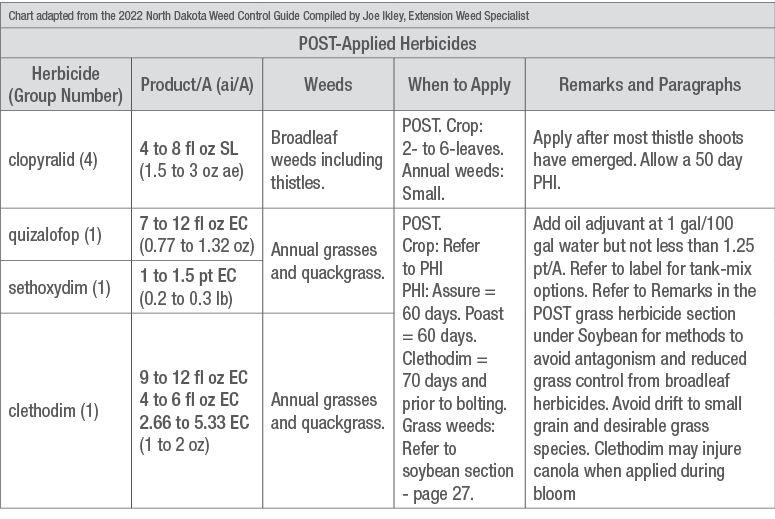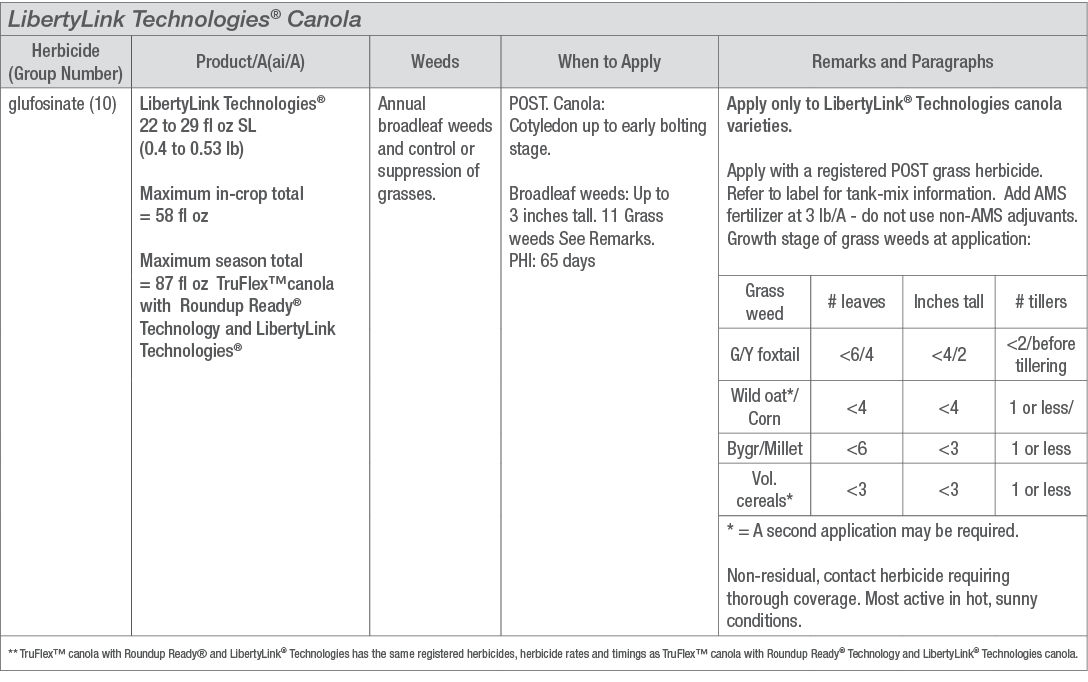Adapting Your Weed Management Plan in Canola
June 28, 2022
Introduction
Weed management is essential for profitable canola production.1 Yield loss from weed competition is highest in canola when weeds are growing prior to crop emergence or from weeds that emerge prior to the two-leaf canola growth stage. It is critical to get the canola off to a good start by controlling weed competition early in the season and not delay herbicide application until all weeds have emerged. Weeds are highly competitive and can use important resources that include moisture, nutrients, and access to sunlight that would otherwise be available to the canola crop.1 It is important to understand what the alternative weed control options are with the potential for limited glyphosate and glufosinate supplies and as more weed species become resistant to these herbicides.
Preplant weed control options.
Burn-down herbicide weed control program
With a potential industry shortage of glyphosate many of the preferred preplant burn-down and in crop herbicide programs may be limited. With the potential of a glyphosate shortage, the first important consideration is if there is enough availability for a single application this season and when would that application provide the most benefit? Glyphosate could be utilized as the burndown application in a no-till production system before planting. It is critical to get the canola off to a good start by controlling weed competition early in the season. Other non-glyphosate burn-down herbicide options or glyphosate tank combinations are available, but it is important to understand the weed species that these herbicide options control or suppress and understand any pH, soil type and delayed planting intervals.
Multiple Effective Modes of Actions
Another item to consider when developing an herbicide plan is to consider including another effective mode of action to help enhance weed control and manage weed resistance. One of the best opportunities to include an additional mode of action is in the burn-down or pre-emergent glyphosate application.
Soil-applied herbicide weed control program
Soil-applied herbicide programs were very common prior to the widespread adoption of no-till production strategies. These programs became the preferred production strategies with the use of glyphosate and other herbicides used as a burndown application instead of tillage. Granular formulations of these soil-applied herbicide can be used in no-till farming or minimum till systems because it is less likely to be tied up in the residue like a liquid formulation. Soil-applied, pre-emergence herbicide programs often incorporate the herbicide into the shallow soil volume with moisture or two shallow tillage passes, two to four inches deep. This herbicide application can take place in the fall when soil temperatures drop below 41o F or in the spring 10 to 14 days before planting and is designed to inhibit weed germination. Moisture (in the form of rain or irrigation) is usually needed for incorporation to help maximize the herbicide activity. If tillage is used to kill established weeds and to incorporate the preemergence herbicide prior to seeding canola, it is important to not work the soil when it is too wet as tillage can create soil clods. A seed bed that allows the producer to place the seed ½ to one inch deep in a soil with good tilth is critical. A cloddy seed bed can cause a lot of problems with herbicide incorporation, accurate seed depth placement and proper seed-to-soil contact.

Figure 1. Preplant canola herbicide options for North Dakota.2 Figure adapted from the 2022 North Dakota Weed Control Guide Compiled by Joe Ikley, Extension Weed Specialist
In crop, post emerge, herbicide options
Weeds are likely to be smaller and easier to control early in the season. If possible, plan to apply a first pass of post emergence herbicide between the cotyledon and two-leaf stage to help maximize yield potential. This allows for a follow-up application with a second in-crop application to help manage the next flush of annual and/or perennials weeds before the canopy closes. There are a few minimal in crop herbicide options available, but it is important to understand the weed species that these herbicide options control, but also understand any pH, soil type, preharvest intervals, re-cropping intervals or any other crop production considerations.

Figure 2. Postemergence herbicide options in canola.2 Figure adapted from the 2022 North Dakota Weed Control Guide Compiled by Joe Ikley, Extension Weed Specialist. Always follow up with your local representative to help determine the best tank mix options. Always read and follow label instructions.
Post-emergent Herbicide tolerant canola products
A vast majority of canola seed available today has some type of herbicide tolerance. These products allow for the over the top, in crop, application of herbicides that will injure conventional canola products.

Chart adapted from the 2022 North Dakota Weed Control Guide Compiled by Joe Ikley, Extension Weed Specialist

Figure 3. Postemergence herbicide options in herbicide tolerant canola.2
TruFlex™ canola with Roundup Ready® and Liberty Link® Technologies
Growers with TruFlex™ canola with Roundup Ready® and Liberty Link® Technologies can choose between application combinations with either Roundup® herbicide brands or Liberty® brand herbicides for weed spectrum control that exist in their field. Depending on the problem weeds in the field and focusing on early herbicide application, using these herbicides in different combinations can be helpful. For example, if wild oats or yellow or green foxtail grass are the concerns, starting with Roundup® herbicide brands will be the most beneficial. An application of Liberty® brand herbicides can help manage glyphosate-resistant kochia when the kochia is smaller than 4 inches. A follow-up application of herbicide can be utilized as needed depending on weed pressure and herbicide availability.
Considerations when changing a canola herbicide program
When considering an herbicide change for any reason there are many issues to consider:
- Assess fields for weed species present and weed density to understand the effectiveness of available herbicide programs.
- Consider how soil pH, soil type, harvest restrictions, weed size limitations, minimum rotational interval and precipitation may affect timing and herbicide rates for herbicide programs and following crop rotations.
- Understand the tank mix restrictions with any combination of herbicides, insecticides, and fungicides.
- Understands the cost of an alternate herbicide program.
- Temperatures can affect weed control efficacy and depends on the type of herbicide application, the rate applied, and the physiological status of the target weed.
- Watch in-season availability and cost of any herbicide program when replacing a glyphosate or glufosinate as there can be a domino effect creating supply issues for alternative herbicide programs.
Conclusion
Early weed control that consists of a burn-down herbicide application or preplant tillage followed by an in-crop application before the four-leaf stage of the crop is often enough weed control needed, depending on the weed species.1 Whenever considering any herbicide program consult your local agronomist or Ag Chemical supplier to identify your soil types, weed species and environmental conditions. Always read and follow the most recent chemical label.
Sources
1 2021. Canola Council. Weed management. Canola Encyclopedia.
https://www.canolacouncil.org/canola-encyclopedia/weeds/weed-management/.
2 North Dakota Weed Control Guide. 2019
https://www.ag.ndsu.edu/publications/crops/canola-production-field-guide.
2023_12950